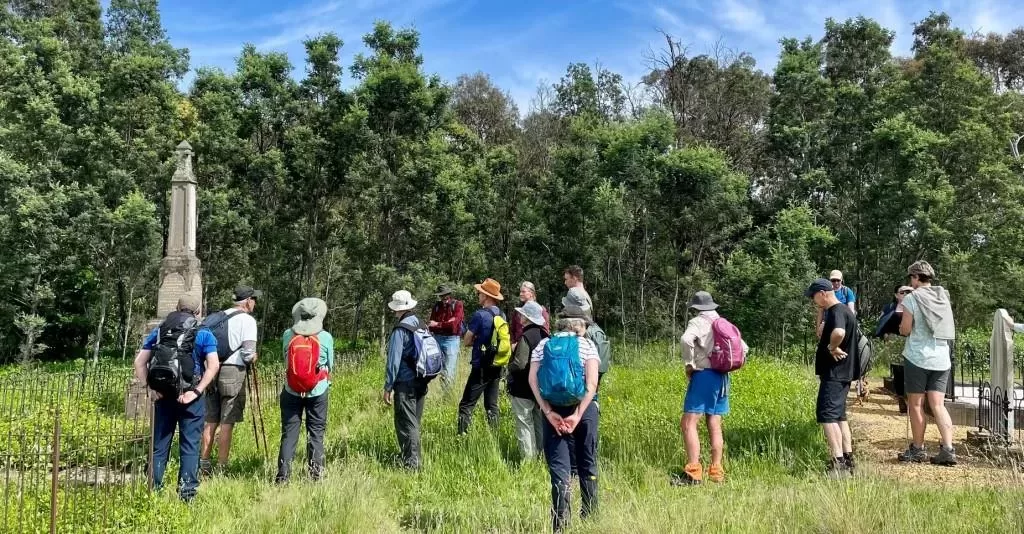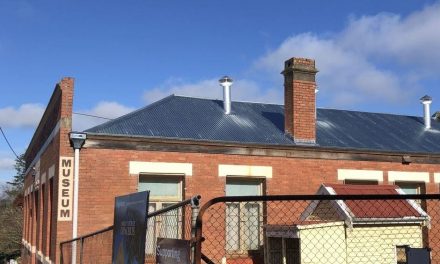The historic Loddon Aboriginal Protectorate settlement at Franklinford was the focus of guided walks by the Great Dividing Trail Association last week.
The Protectorate was established in 1841 by Assistant Aboriginal Proctor Edward Parker after the failure of a similar settlement near Baringhup earlier that year.
Protectorates were established by the British colonial government in an attempt to avoid the prolonged bloodshed that had already occurred in Van Diemen’s Land (Tasmania) between the Palawa people and the colonists. The Colony of Victoria was divided into four divisions, each with an Aboriginal Protector who would make contact with Aboriginal people and encourage them to leave their land and seek refuge for their own safety. It was also thought that they could be managed, civilised, settled, Christianised and encouraged to work the land for agriculture. At its peak, the Franklinford Protectorate had a population of 300 Dja Dja Wurrung and Aboriginal people from elsewhere. It consisted of a school, church, administrative centre, workshops, farm, medical outpost, flour mill and lime kiln.
Dja Dja Wurrung people from diverse clans over a huge area from the Loddon to Avoca rivers were brought together in close proximity off Country. They were not only broken and dispirited, but also prone to disease, conflict and starvation. The Protectorate’s five miles radius was minuscule in terms of the expectation that hundreds of people could somehow eke subsistence from farming, hunting and fishing. Today, we would call the Protectorate a refugee camp.

A rustic iron signerected by local historian Edgar Morrison marks the site of the original Aboriginal School House.
On November 12 and 13, GDTA member Barry Golding led walkers on two tours of the Franklinford settlement. The walk on November 13, open to the public, followed the course described in the GDTA’s Central Victorian Highlands Walk and Ride Circuits booklet. A walk on the previous day, open only to GDTA members, included a 5km loop through the Sartori private property to the site of the Protectorate’s flour mill on Larnibarramul Yaluk.
The public walk on November 13 started with a welcome to country and smoking ceremony by Dja Dja Wurrung elder, Uncle Ricky Nelson.
Over 40 people joined the public walk on Sunday including Mayor, Cr Tim Drylie, and Councillors Jen Bray and Tessa Halliday.
The walks started at Franklinford Streamside Reserve, near the delightful Clarks Pool formed by a sharp bend in Larnibarramul Yaluk which surrounds the Reserve.
The walks included visits to the Franklinford Cemetery, Thomas’ Spring, a monument to Edward Parker on the main town intersection, the original main Protectorate site, later the site of the Aboriginal School. There were beautiful views over Larnibarramul Lagoon towards Mount Franklin.
The only present-day reminders of the existence of the Protectorate are to be found in rustic wrought iron roadside signs and a symbolic stone cairn erected by local historian Edgar Morrison in the 1960s. The current Franklinford cemetery encloses the older Protectorate era cemetery dating back to 1842. The graves of Edward Parker and his wife and family are marked by an upstanding obelisk and fenced grave site. Presumably Dja Dja Wurrung and other Aboriginal bodies are buried in the cemetery but their graves are unmarked.
In a token gesture of reparation in 2013, the government handed back to Traditional Owners just one hectare containing a few foundation stones from the former Aboriginal School Site.











